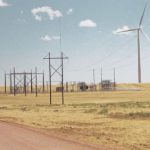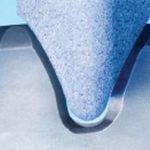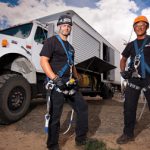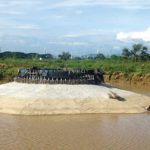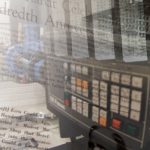The discussion is heated and the room is tense. Healthy discussion and debate go on back-and -forth day after day in the fourth-floor conference room of Vic Abate, vice president of General Electric’s renewable energy business. Above the entrance to the room in black writing, a quote from GE founder Thomas Edison: “I find out what the world needs, then I proceed to invent it.”
This Schenectady, New York conference room is one of the places where this innovation happens. Another is with GE’s engineering teams, based in Greenville, South Carolina, where some of the world’s brightest minds in power generation have convened to develop and innovate for the world’s future energy demands. For the past 10 years, innovation has been happening at GE’s wind business locations across the globe. With 21,000 installed turbines and a global services organization, GE’s wind team is home to some of the most experienced in the industry.
With new product launches every few months, this innovation hub churns out new products and technology that keep GE’s wind customers at the top of their game. This isn’t surprising as GE itself was established on a foundation of innovation that has stayed with the company throughout its 120-plus years.
GE’s renewable energy business, goes to work every day with a purpose —to deliver products and services that move the wind industry forward and make the world a better place. Earlier this year at the European Wind Energy Association trade show in Vienna, Austria, the company launched another one of its innovative products—the 2.5-120 wind turbine. This is the latest model in GE’s product line, and is the result of 10 years of dedicated research and development into a single product.
GE bought the wind business from Enron in 2002 and began immediately to improve upon the technology to become the number one OEM in the wind energy industry. The launch of the 2.5-120 is a prime example of GE’s ability to provide differentiated technology. The turbine utilizes the latest and most advanced technology from across the company’s wind turbine product line, incorporating technology developed in complementary GE businesses, and work performed at GE’s global research and development centers. Adjacencies can be seen across GE businesses as experts in rotating machinery collaborate with the aviation, healthcare, and power generation segments.
It is also the world’s first “brilliant” wind turbine. Brilliant turbines house powerful applications that integrate advanced algorithms, communications, and energy storage—making intelligent decisions and driving the industrial Internet of wind.
Over the years, GE has invested more than $2 billion in renewable energy technology. Much of that allocation can be seen in the launch of the 2.5-120. Branded the first “brilliant” wind turbine, the 2.5-120 is the world’s most efficient, high-output turbine and is the first turbine to manage the variability of wind, providing smooth and predictable renewable power. The turbine does this by using software controls and advanced communications to connect wind farm to wind farm; wind farm to grid; wind turbine to remote operations; turbine to technician; turbine to turbine; and turbine to battery.
Although just recently officially launched in February, the 2.5-120 is part of the company’s multi-generational product plan. Ideas to integrate communications technologies evolved and built upon one another as the turbine was under development by GE’s global engineering and product management team that works together on new products. Figure 1
Innovation begins, as Thomas Edison mentioned, by knowing what the world needs. The 2.5-120 was designed to send wind energy where it’s never been before. Launching initially in the European market, and later following in the U.S., the turbine provides smart communications and more efficient, high output for low-wind sites. Both Europe and the U.S. have been growing markets for wind energy and pose specific opportunities and challenges for developers. The low wind speeds require large rotors and tall towers, while older, narrower roadways often create logistical obstacles. Throughout most of Europe, wind is economical and there are also rivers and waterways that make traveling and delivering equipment by barge feasible, which made Europe an ideal initial launch region.
Additionally, the goal of making wind power behave more like traditional power generation is always floating about in the wind industry. GE has deep understanding of grid integration challenges due to its long history in the power generation industry. In fact, in the U.S., the Edison Electric Company was one of the initial developers of much of the American power grid network. GE maintains a holistic approach to power generation and understands how it influences the stability or frequency of the grid. The company recognized a need in developing a plan to make wind power more like traditional power generation. With these challenges at hand, the GE team went about developing the smartest and most advanced turbine to tackle this landscape.
When developing this new unit and surveying the landscape in Europe and the U.S., GE’s objectives were clear: The rotor needs to get larger and the tower needs to be taller. Making those objectives become reality was another question. The company has an evolutionary approach to wind turbine development—an approach that has been successful for a decade through numerous product launches. The company looks at its current fleet and assesses components that work best in one model. They then attempt to incorporate those elements into what is working best in another platform.
For example, the team used this approach when they looked across the product line and realized that the doubly fed induction generator (DFIG) used in the 1.X platform was a premier generator in the industry. The team came to the consensus that the generator should be used not just in the 1.X platform, but also in the 2.X turbine line.
In order to enhance the turbine and grow the rotor dimension, the DFIG electrical system was incorporated into the turbine. The new system enabled the use of longer, low-load blades that capture a large amount of energy without overtaxing the machine. The new rotor, combined with a modified gearbox and advanced controls is the chief technological advancement in the 2.5-120 turbine.
Incorporating DFIG technology into wind turbines not only provides higher efficiency and power (due to its larger rotor). The technology allows for a more serviceable turbine for industry technicians who cut their teeth on DFIGs. GE’s wind business uses Mark VI* controllers that are the same technology that are used in GE Power & Water’s thermal power generation equipment. Wind technicians who previously worked on nuclear machines are able to transition easily into a role in the wind energy industry because the turbines are using the technology with which they are already familiar. Mark VI* is a well-proven software and hardware technology used to control industrial machinery.
Since this technology is a staple across GE’s business segments, the company has years of expertise developing complementary technologies for the Mark VI* controller. An enabling technology for many of GE’s aftermarket service upgrades, controls software, and anomaly detection capabilities come from the company’s years extensive knowledge and experience related to the Mark VI* technology.
Using technologies from existing turbine platforms is not a new idea exclusive to the 2.5-120 development for GE. This synergistic approach among the 1.X and 2.X platforms was used earlier in the development of GE’s 1.6-100 wind turbine. The 1.6-100 was developed after the company had success with the hub and blades from the 2.5-100. GE has the goal of ensuring that the two platform teams don’t view themselves as two separate entities. Rather, the teams are encouraged to collaborate in an environment where the free flow of ideas and lessons learned benefits both teams and a “best practices”approach is adopted. Figure 2
The evolution furthered when the company utilized research and technology originally developed for the 1.6-100 platform into the creation of the 2.5-120. GE’s 1.6-100 turbines were the first products to include some of the most advanced loads mitigation technologies. This feature was subsequently incorporated into the 2.5-120. The “brilliance” in the 2.5-120 is made up of a number of technologies that GE provides. Drawing on its vast resources as a large, international organization, GE has unique technology development capabilities. Among these are the expertise of personnel in the thermal power generation businesses, as well as the central R&D hubs located within the company’s numerous research centers. In total, more than 2,000 engineers and scientists—the majority of which hold Ph.D’s—work at the company’s global research and development centers.
Model-based controls first appeared in the 1.6-100 turbine and were the result of projects conducted at GE’s research centers. These systems are now an integral feature of the new 2.5-120. GE Global Research is also working on the extreme event mitigation technologies—which work to reduce potentially harmful excessive loads—for inclusion in the 2.5-120. Traditionally, wind turbines react to extreme loads as they occur. The generator is programmed to run at a certain speed. When that speed is exceeded, the turbine shuts down. This results in harsh, immediate stoppage, which in turn places a heavy load on the equipment. The new extreme event mitigation technology incorporates unique algorithms that detect data signatures in the turbine’s operations that could lead to a potential extreme event. Rather than reacting to an event, the turbine predicts it and pitches the blade prior to an “emergency braking” situation. This saves the customer by avoiding lost power, and extends the turbine lifespan by avoiding an extreme loads situation.
One final way that GE infuses technology into its turbines and drives innovation forward is through the use of data collection and analysis. As turbine technology has advanced, the number of sensors and volume of information those sensors provide has grown. Similarly, the analysis functions performed on that data has expanded. GE has, on average, about 50 sensors on each turbine. Data is collected from about 150 different sources on the turbine. These sensors measure temperature, wind speeds, speed, bending, current, voltage and location and pitch of the blades. Today, data collection capabilities are three- to fivefold what they were a few years ago. GE’s turbines collect and analyze 150,000 data points every second to integrate 400MW of wind power into the grid. This information is immediately integrated into turbine operation for smarter servicing and maintenance, and is also used it in the development of future products.The 2.5-120 prototype system is currently underway and is tailor-made for low wind speed sites.
The design of GE’s latest wind turbine incorporates the expertise and knowledge developed over years of data collection, power generation expertise, and knowledge of what works and what doesn’t in the wind industry. It was designed with the goal of providing a highly efficient, higher-output turbine to the wind energy industry.





















